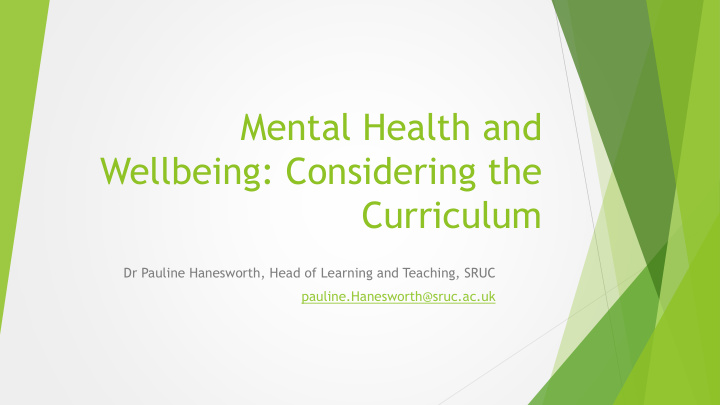



Mental Health and Wellbeing: Considering the Curriculum Dr Pauline Hanesworth, Head of Learning and Teaching, SRUC pauline.Hanesworth@sruc.ac.uk
Context 62,685 more students in the UK disclosing a mental health condition than in 2007/08 (2007/08: 9,675, 2017/18: 72,360) [Advance HE]. 23.9% of students in the UK disclosing a disability in 2017/18, disclosed a mental health condition (2007/08: 5.9%) [Advance HE]. 37% of survey respondents with a mental health condition had, or intended to, declare it with their institution. [HEPI-UNITE Students]. 17% of students felt the things they do in their life were very worthwhile and that they were very happy, while 18% stated they had very low anxiety (total UK population = 36%, 35% and 41% respectively) [HEA-HEPI]. 2
Academics at the frontline Academics identified that responding to student mental health problems is now an inevitable part of the academic role . Academics are often the first point of contact for students experiencing difficulties. Students may turn to academics for advice because they are approachable, accessible and have a pre-existing relationship with the student. However, this crucial frontline role is currently invisible, and the sector does not have the appropriate structures or cultures to assist academics. 3
Two Continuum Model (1988) 4
Mental wellbeing and education Education has a measurable impact on wellbeing, through all stages of life: directly, enabling us to develop capabilities which influence our wellbeing; 1) indirectly, leading to outcomes that, in turn, allow us to increase our 2) resilience and capacity to thrive, and cumulatively, by influencing the social and economic environment in which 3) we spend our lives (Field, 2009). Conversely, a low level of mental wellbeing, and its physical consequences can significantly impede our capacity to learn. That is because of how it affects our concentration, motivation, self-confidence, self-efficacy and ability to attend sessions or to engage with assessment (Craig and Zinckiewicz, 2010, Tinklin et al, 2005, Quinn et al, 2009). (Houghton and Anderson, 2017) 5
Mental wellbeing and education Make it visible and 1. explicit. Address within 2. habitual practices of lecturing / teaching staff. 3. Address through existent activities. 6
Mental wellbeing and education 7
Making it visible and explicit Curriculum content 8
Making it visible and explicit Curriculum design QAA Scotland Transitions Map 9
Curriculum process 10
Connect There is no personal contact. . . you don’t really speak to the tutors. . . it makes you feel alone. I made [friends] through my seminars, really. I got four really good friends, and I’ve just clicked with them straight away, and then we sit together in lectures and stuff. And now I’m working on this project with them and we’ve been meeting up outside of Uni and stuff. 11
Be Active 12
Take Notice I felt embarrassed talking about some of the private things we covered. I couldn't see how it was relevant to my university work. [The lecturer’s] bringing our reading into our conversation helped me connect my personal with the political. [sic] I have learned to really think about my studies. Not just learn and listen. But think long and hard about what we are learning means [sic]. Not just to me but to others. 13
Give 14
Keep Learning When designing courses, there is a tendency for academic staff to focus on what they need to do, preparing the lecture, developing the experiment, constructing the problem based case study. However, there is much they can do to foster independence and self-direction amongst students that will increase engagement in the course. (Houghton and Anderson, 2017) 15
Embedding Wellbeing and Students 16
Recommend
More recommend